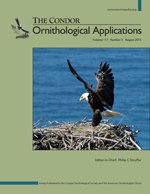Steller's Eiders (Polysticta stelleri) that breed in Alaska, USA, are listed as threatened under the U.S. Endangered Species Act (ESA), yet the degree to which these individuals segregate during the nonbreeding period from conspecifics that nest in Russia is unknown. Likewise, very little is known about the timing of use and distribution of autumn migration routes, stopover sites, and molting and wintering areas by the Alaska-breeding population. To address this information need, we implanted 14 Steller's Eiders with satellite transmitters in 2000 and 2001 at their primary Alaskan breeding grounds near Barrow. We found no evidence for segregation of the Alaska-breeding population in midwinter because locations were well-distributed along the Alaska Peninsula, congruent with prevailing knowledge about the wintering distribution of Steller's Eiders that breed in Russia. During the wing molt, from late August to early October, 7 of 13 individuals used Kuskokwim Shoals, corroborating the importance of this area and its designation as critical habitat under the ESA. Steller's Eiders are generally described as preferring shallow waters <10 m deep, but our winter tracking data clearly documented occupancy of deeper offshore waters. Steller's Eiders frequently used up to 30-m deep water almost exclusively at night during winter. We speculate that nighttime occupancy of deeper water habitats may be for resting and/or for consumption of zooplankton species, such as euphausiids, that are abundant and well known for their nocturnal vertical migrations in the water column.
How to translate text using browser tools
10 June 2015
Distribution and movements of Alaska-breeding Steller's Eiders in the nonbreeding period
Philip D. Martin,
David C. Douglas,
Tim Obritschkewitsch,
Shannon Torrence
ACCESS THE FULL ARTICLE

The Condor
Vol. 117 • No. 3
August 2015
Vol. 117 • No. 3
August 2015
Alaska
distribution
Endangered Species Act
marine habitat
movements
satellite telemetry
Steller's Eider




